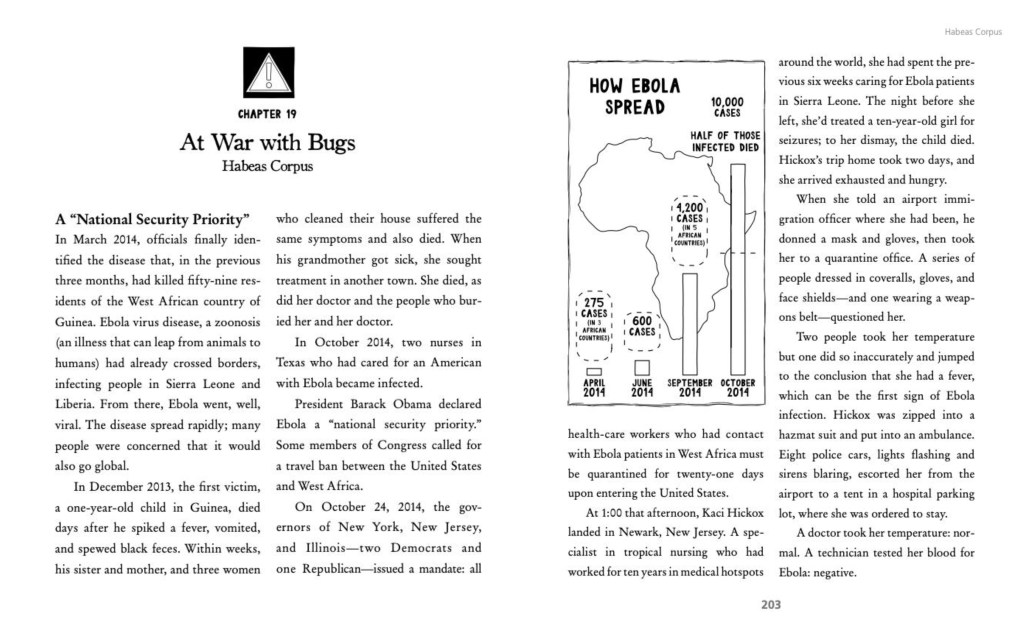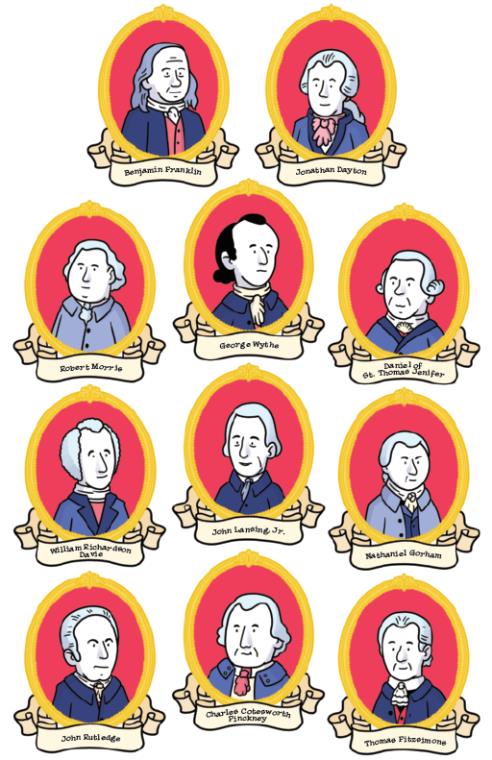
We are thrilled to announce that there are now two ways to read Fault Lines in the Constitution—the text version from Peachtree Publishing Company and the graphic novel from First Second Books/Macmillan. We are grateful to our publishers, editors, artists and art directors, and many others behind the scenes at both houses who worked hard to make sure these books complement each other so well.
You can see the differences and similarities by looking at the first two matching pages of a chapter that is especially relevant today—Chapter 19, “At War with Bugs: Habeas Corpus,” which is about an epidemic. (The full text version of this chapter—along with that of Chapter 18, “At War: Emergency Powers”—is here. The corresponding full graphic novel version of Chapter 19—along with that of Chapter 12, “the college with no courses or credits: the electoral college”—is here.)


What do you notice in terms of the amount of information provided? What about the ways the information, dialogue, and story are conveyed? Do you prefer one style over the other?
The illustrator of the graphic version is Ally Shwed, who was perfect for this job. She majored in Literature and American Studies in college and received an MFA in Sequential Art from the Savannah College of Art & Design. In addition, she describes herself as a “concerned citizen who cares about her country and is fearful of what will happen if systematic change doesn’t happen soon.” As we said, perfect!
Because we were unfamiliar with how comic books are designed and drawn, we asked Ally some questions. Here are her responses, edited for brevity.
Us: How did you decide which text to delete and revise from the original version of Fault Lines in the Constitution and which to leave as is?
Ally: My process started by rewriting the text into a script format, breaking it down into pages and panels. Then, I figure out where material needed to be reduced, rearranged or omitted. The goal is to reach a balance of images and text. That’s especially challenging with nonfiction books because you’re striving for a narrative with good pacing that also retains the pedagogical elements intact. In some places, I used a visual essay design to make sure the lessons would be complete. But I didn’t want to do that too much because no wants a lot of talking heads.
Us: An example of a place where the text matters comes from Chapter 2, “big states, little say: the senate,” in which we wanted to be sure that both the words and the art convey the problems with every state having two senators, regardless of the size of their populations.

Us: The illustrations are wry and witty, which we love! How did you decide on that tone?
Ally: The tone came naturally as I was scripting the story. I wanted to turn the real people who are in the book into characters. The Framers are such an integral part of the narrative, I started with them, using painted portraits as reference. I guess I read personality into their expressions!
Us: Here’s an example:

Us: How much research did you need to do for the illustrations?
Ally: It definitely took a decent amount. Although the art style I went for was cartoony and pared down, I still needed foundational knowledge of clothing, environments, etc.
Us: How did the team at First Second contribute to the process?
Ally: They were open to letting me be creative but they provided a template and style guide since Fault Lines is part of the World Citizen Comics series. We talked about different ways to approach the structure of the book. For instance, should we use a different color palette for each chapter or make Cynthia and Sandy characters that act as narrators?
Us: We didn’t know that!
Us: What medium did you use to draw the art?
Ally: Photoshop is the program in which I’m most comfortable. It allows me to work fast (read: hit tight deadlines!) and make edits easily.
Us: What was the most fun part of illustrating Fault Lines in the Constitution?
Ally: Seeing the final product in print and holding the book!
You have the chance to hold the books, too. Take your pick—text or graphic or both?

This is AWESOME!
LikeLiked by 1 person
Thanks! We’re feeling way cool!
LikeLike
Great post thhank you
LikeLike